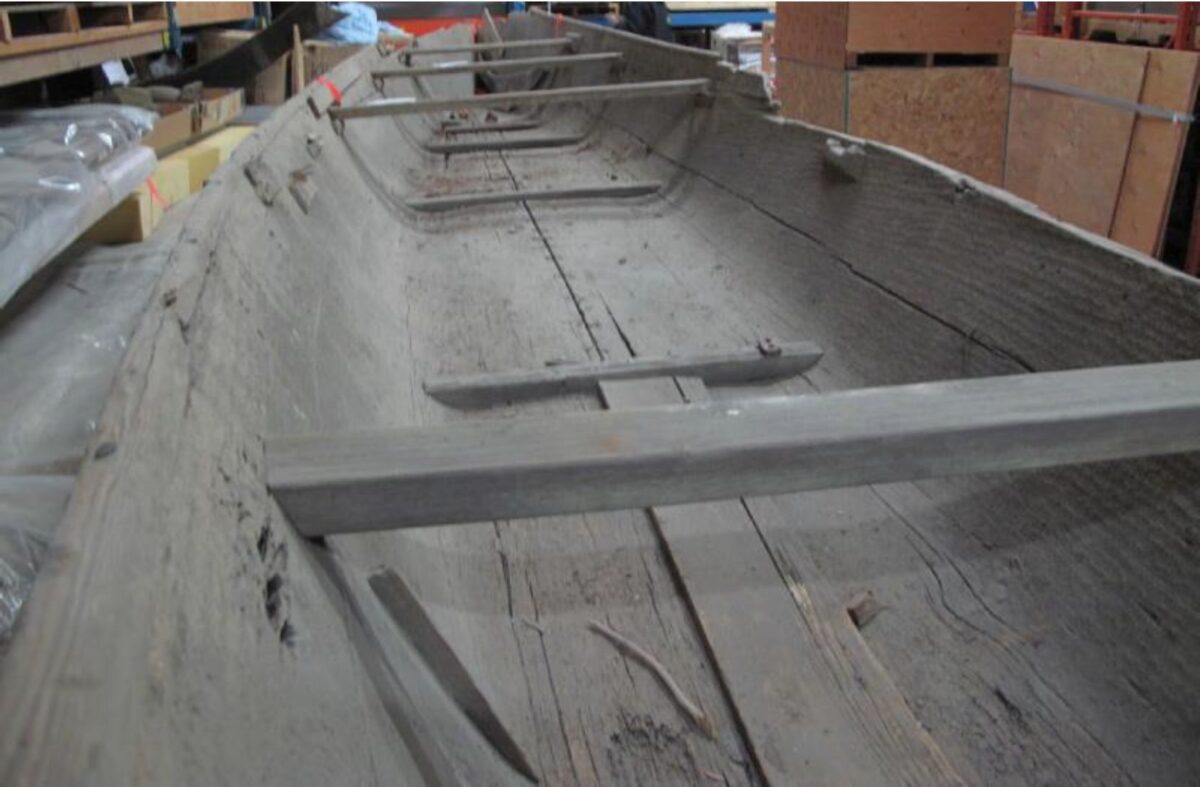November 19, 2019
By Grant Keddie
Have you ever picked up an old object and wondered what sentient beings had held it before? People like you – that are taking the journey from birth to death.
Artifacts are not just things in themselves, they are part of the history of individuals and families. Here I provide what I could piece together of the history of a special large dugout freight canoe in the collection of the Royal BC Museum – artifact number 12048. The genealogy of people and families presented is only a partial one that could be expanded to hundreds of people. I present it to show only some of the family linkages to the canoe and its history – to which younger Indigenous people today can link themselves.
The story of this freight canoe shows the movement and blending of peoples from the west Coast of Vancouver Island, especially the Ditidaht, and families from Sooke, Becher Bay, Saanich and the Lekwungen extending to the Discovery Islands off of Oak Bay, to the lower Fraser River and the Olympic Peninsula.

Figure 1, shows the canoe in action on July 5, 1938. Its owners, unidentified at the time, were in the process of bringing 50 large sacks of seaweed from the Discovery Islands off Oak Bay to sell to the Victoria Chinese for making noodles. Seaweed was an important export that employed many Indigenous peoples. On May 15, 1923, ten tons of seaweed was being shipped out from Victoria to China on the steamship President Jackson. The Daily Colonist reported on this day:
“Every vessel of this line which has departed during the past few months has taken similar cargo from Victoria. Seaweed is used as an ingredient in many Chinese dishes and is esteemed as a great delicacy in the Orient. The gathering of it is a regular business, now becoming highly organized as Indians on the West Coast, where the beds are the richest in the Province, are collecting it for sale to the local Oriental shippers.
In spite of the growing activity of the seaweed exporters, it is not expected that the beds will be depleted very readily. Patrons of Chinese eating houses need not fear inability to secure their repasts of chow Mein.”
The Freight Canoe Story
This large freight canoe, #12048, was purchased from Cecilia Joe (Esquimalt Reserve) and her sister Agnes Dick (Songhees Reserve) on September 1, 1965. At the time it was located as “a derelict canoe” in the front yard of a Dick family house on the Songhees reserve, then occupied by Agnes Dick and Cecilia Joe. At this time the prow was detached and the stern piece was missing.
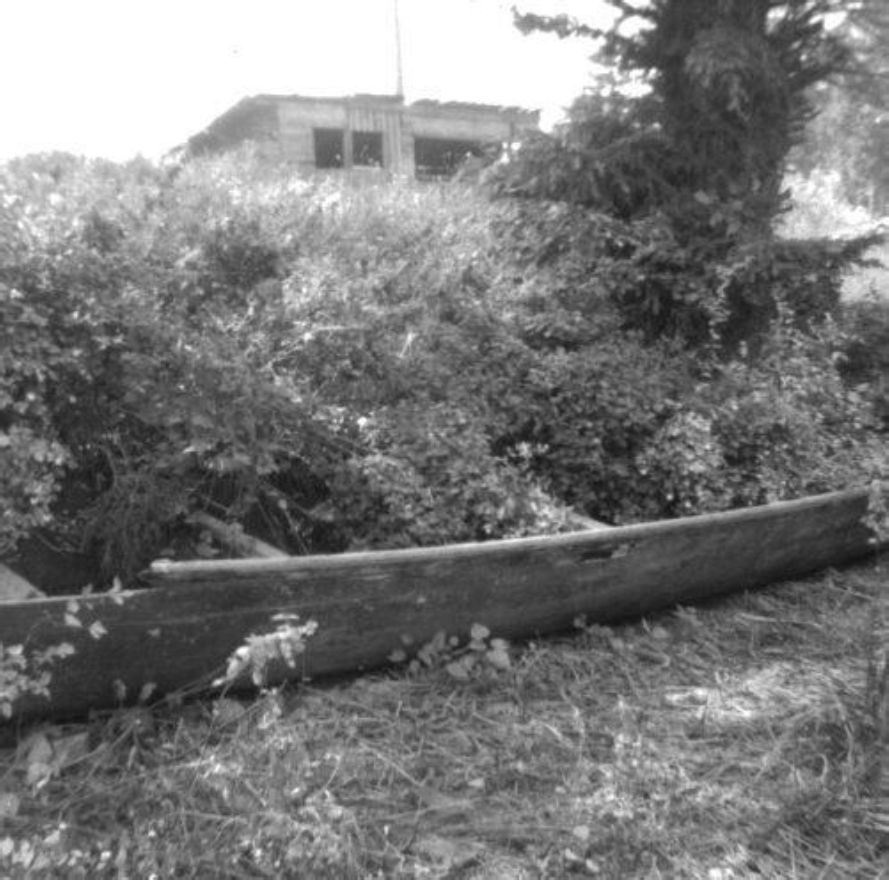
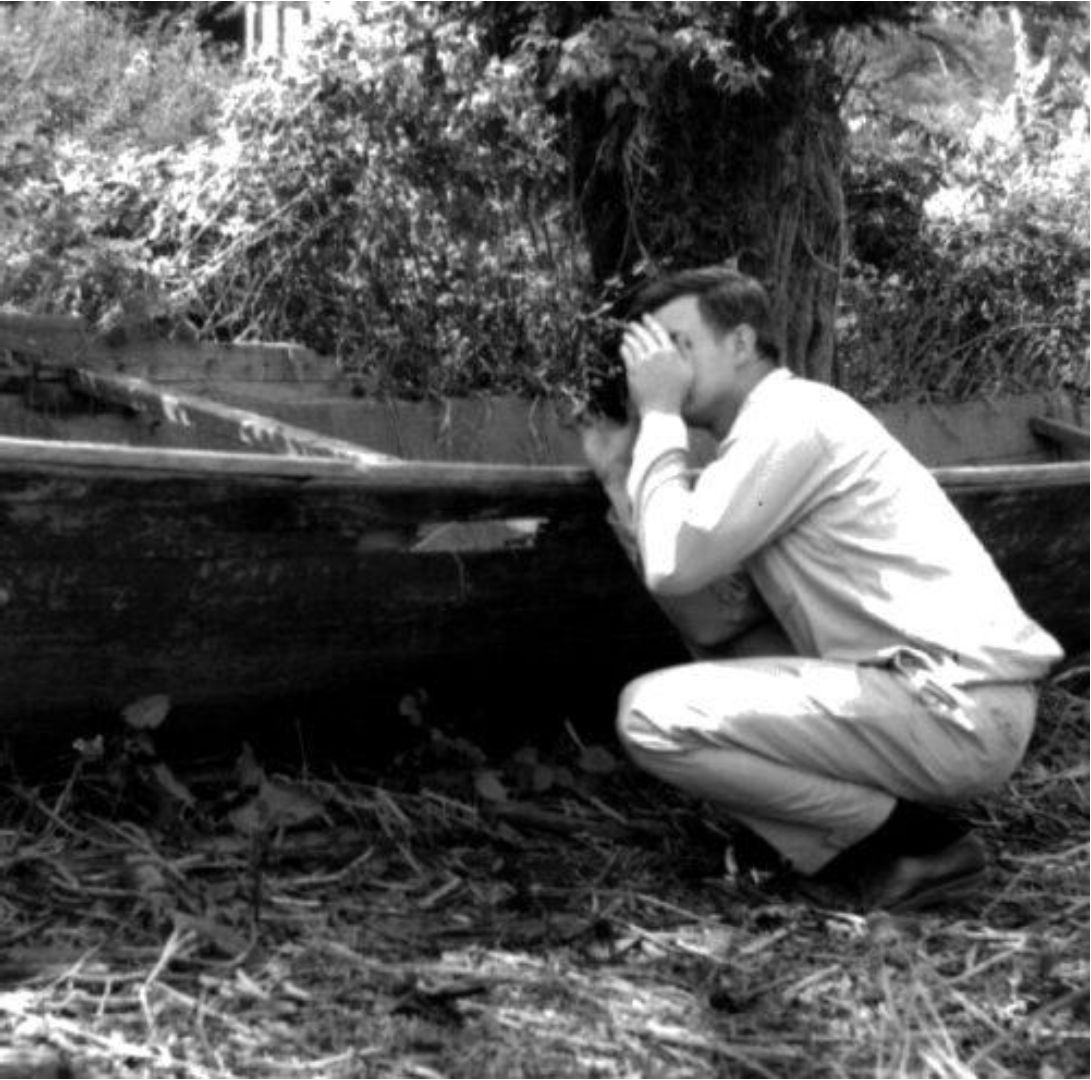
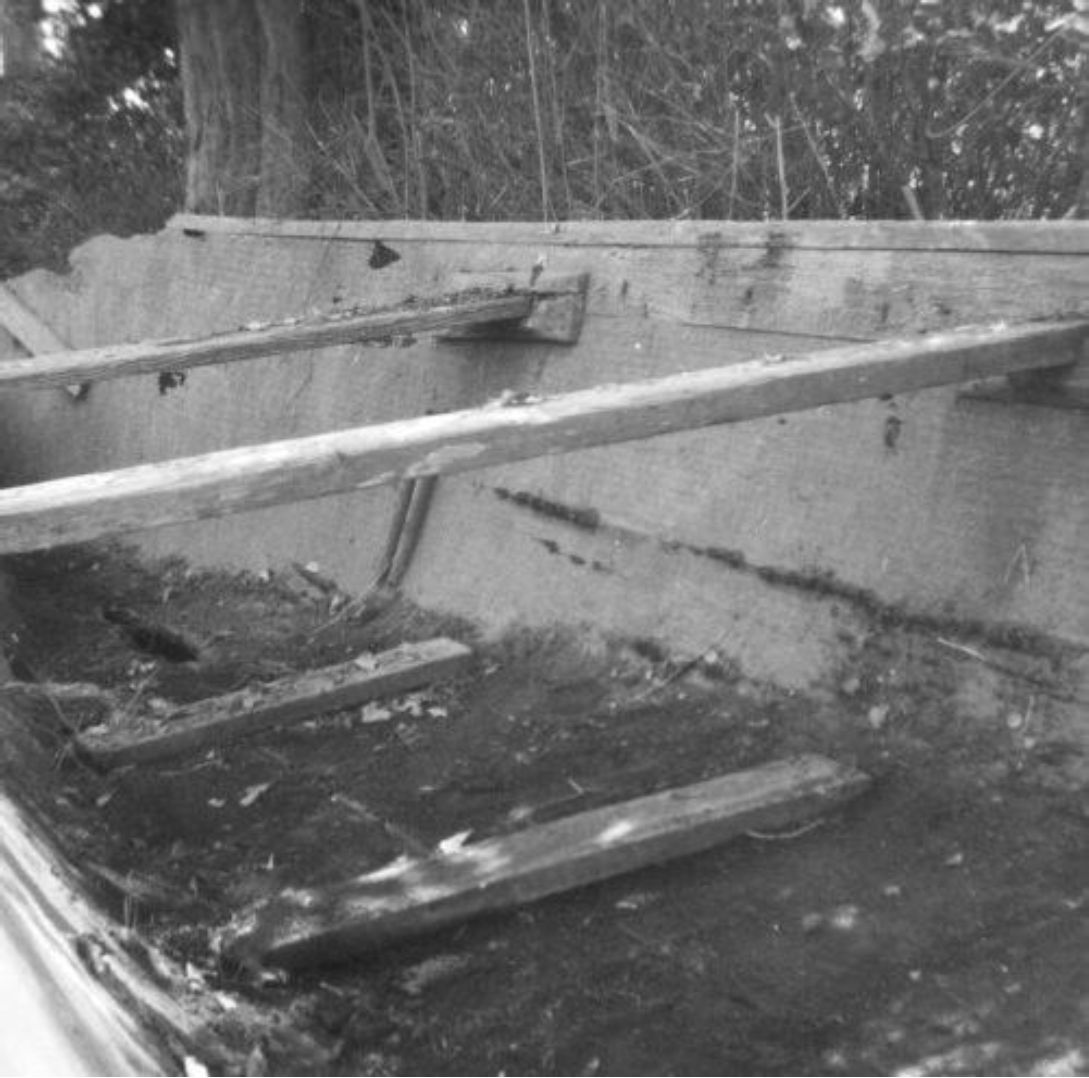
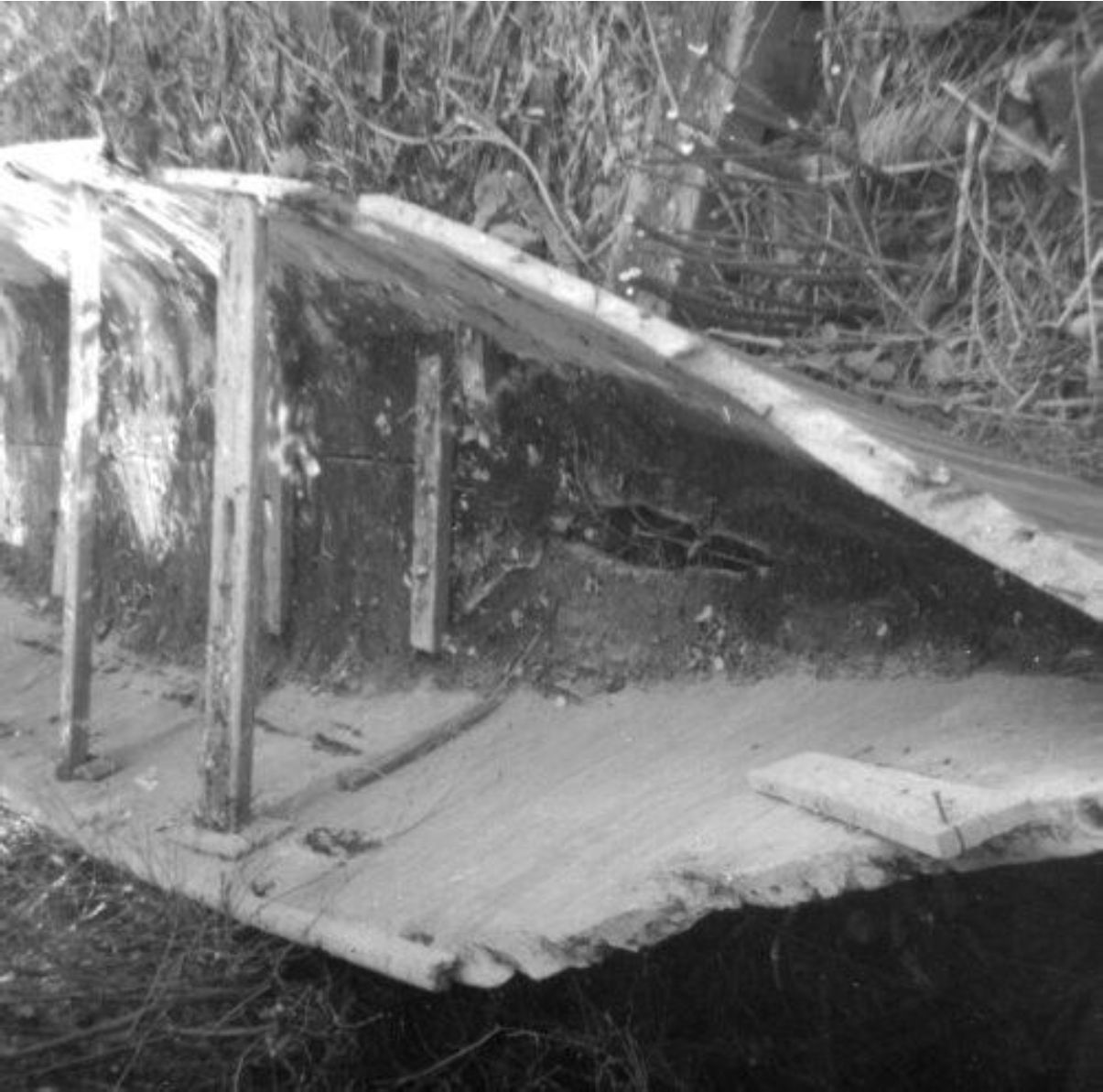
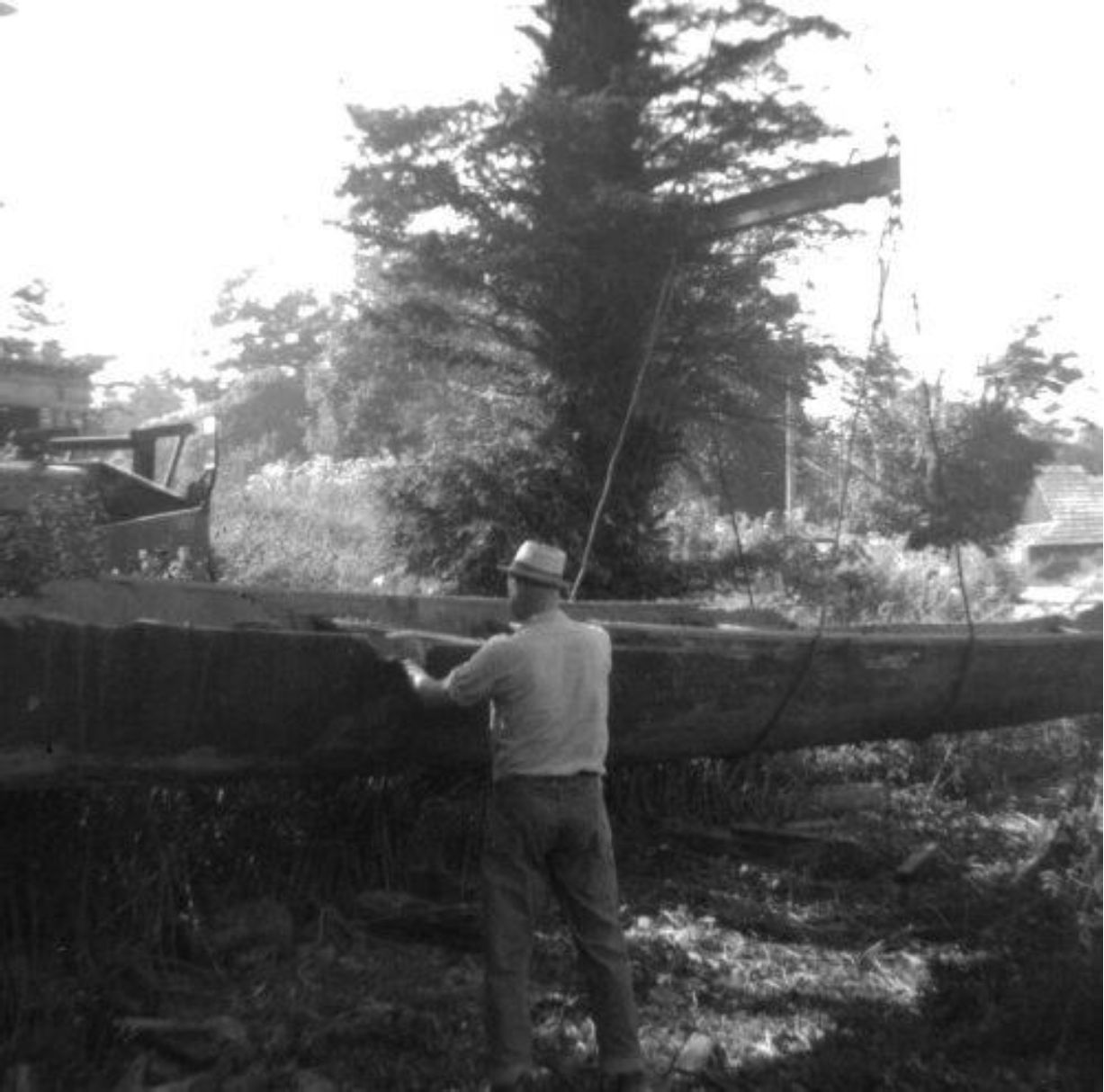
The location and removal of the canoe can be seen in figures 2-6. The canoe was purchased for the Museum by a private buyer Robert Nichols and documented with the assistance of John Smyly of the then Provincial Museum’s exhibits department. Smyly and Nichols took photos of the moving of the canoe and Smyly did detailed drawings with measurements, noting that the canoe was 30’11” long with a beam of 4’10” and depth of 1’10”. With the broken off bow piece the total length would be approximately 34’6” (figures 7-9).

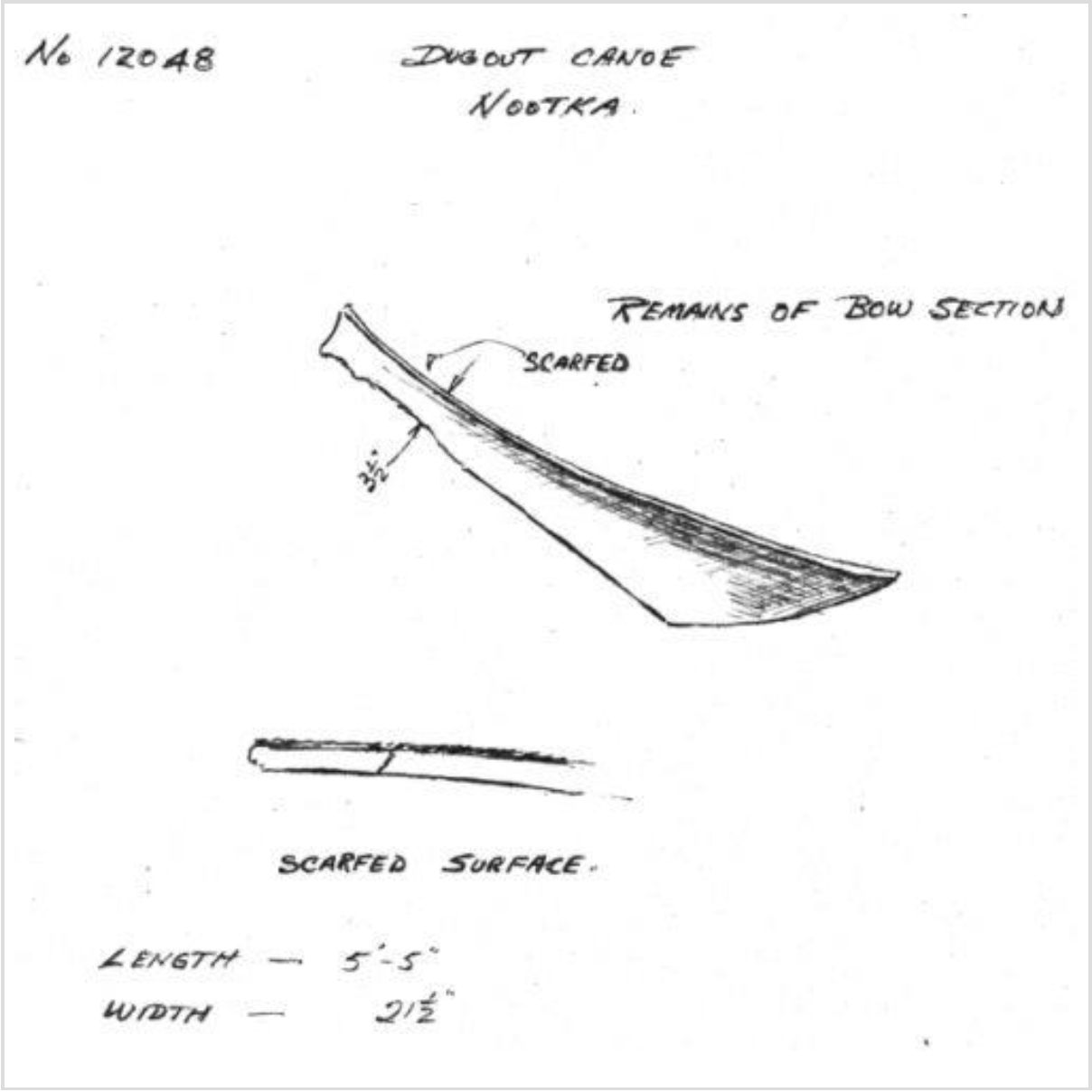
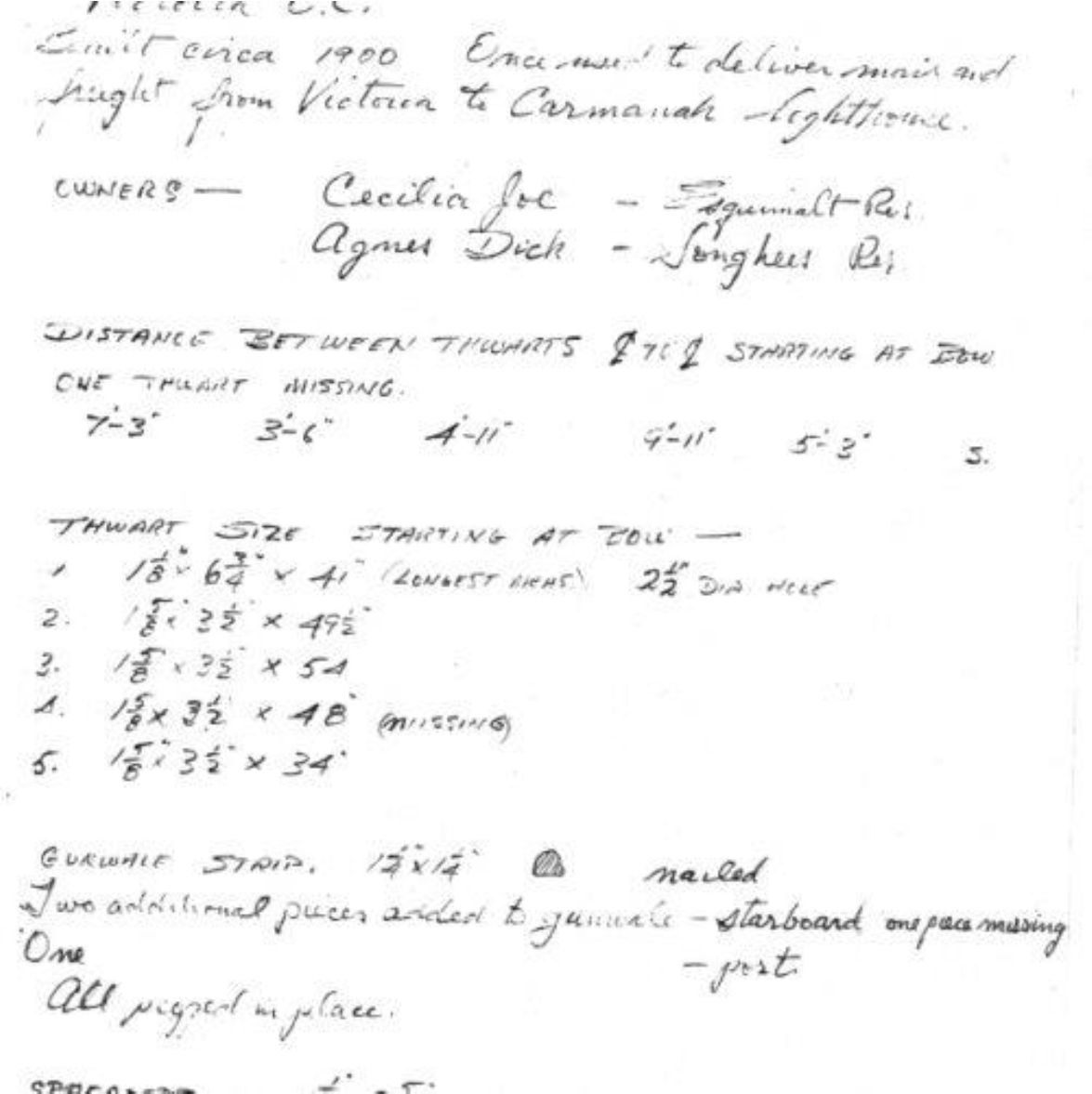
I will here build upon the information about the canoe’s history that was provided by the owners and recorded as follows: “West Coast Canoe. Purchased from Cecilia Joe an d Agnes Dick of Esquimalt and Songhee Reserve. Victoria, B.C. Sept. 1, 1965.
This canoe was built circa 1900 by [unknown person] at Clo-oose or Carmanah or perhaps Nitinat. The owner of the canoe was hired to deliver mail from Victoria to the Carmanah Lighthouse, also Supplies as the ‘Maquina’ was uncertain and often storm bound. Loggers on the west coast often hired the canoe to take them to Victoria when the ‘Maquina’ didn’t show up.
The canoe was sold to Jimmy Smith, an Indian of Clo-oose and later Louis George of Sooke, who married a niece of Smith’s, obtained the canoe.
Agnes Dick and Cecilia Joe, sisters, lived at Sooke when children and were cousins of Louis George. The canoe was used for family travel, fishing, seaweed gathering to sell to the Chinese of Victoria and made many trips throughout the Island water and across to the U.S. villages.
When Cecilia and Agnes were married and moved to the Esquimalt and Songhees Reserves in Victoria, they were given the old canoe about 1918-19. It was used for some years but gradually fell into disuse. For many years it sat on the tide water flat between the two Reserves, old Indian women sat in it in good weather to knit and recall the old days. Children played inside and climbed to the high prow to play at whale and seal hunting. Finally, on September 1, 1965 the old canoe, damaged and a derelict, was purchased and removed to the B.C. Provincial Museum workshop to be preserved.”
The Family Relationships of Agnes Dick and Cecilia Joe. (see note*1).
The relationship of Louis (or “Louie”) George, mentioned as one of the previous owners of the canoe, to Agnes Dick and Cecilia Joe was through their father’s half sister Mary George (Figure 10). Agnes and Cecilia’s father went by the names Charley John and Senupin John. His indigenous names were Senupin and xaxalaqtid. His grandnephew Edward Dick, said he also had the name “Numpton” which in Ditiaht would be “Da’umpton”. Senupin John died in the tragic sinking of the sealing vessel Walter Earl in 1895.
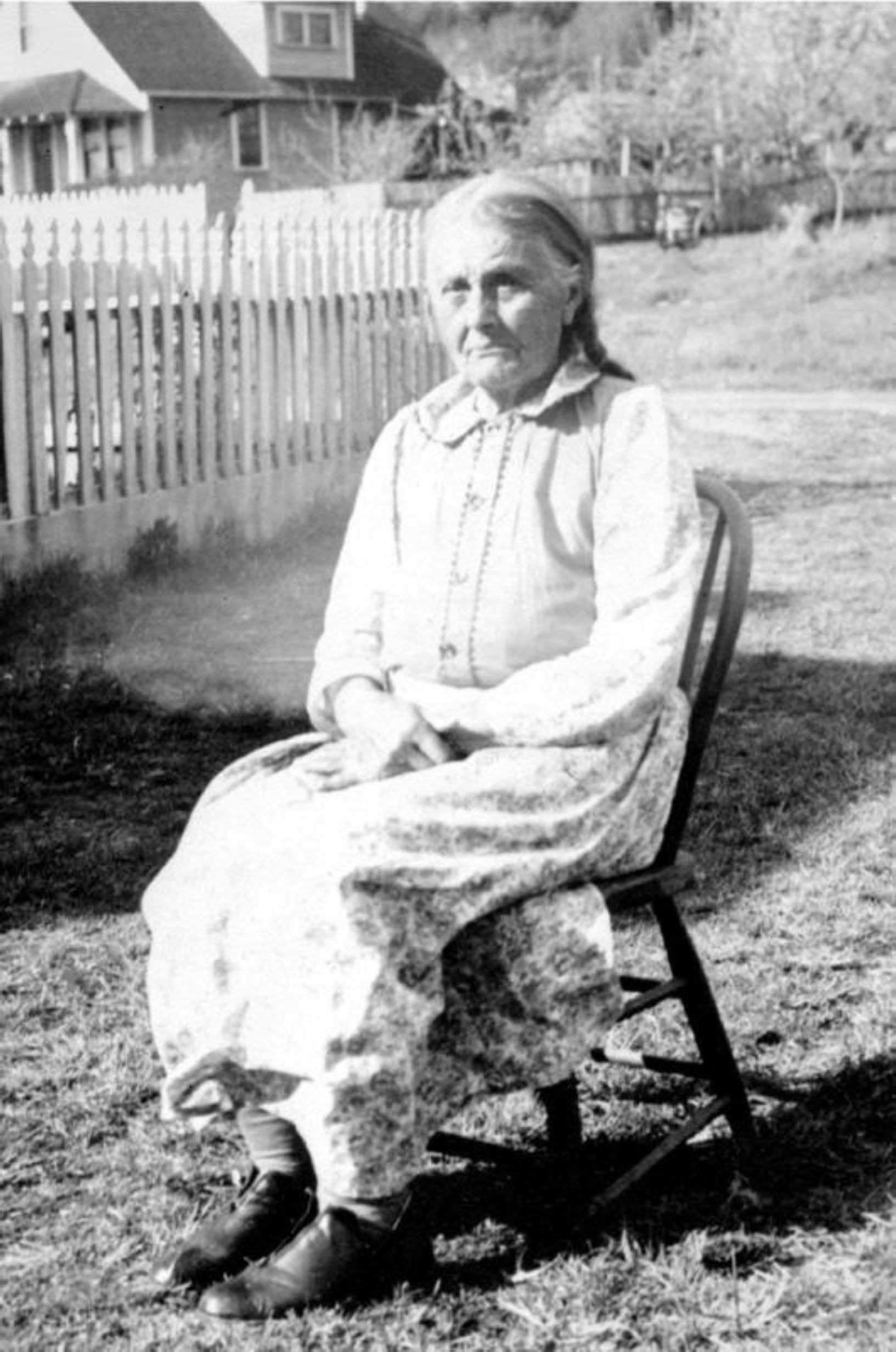

Charley John’s father was a man named Johnson (no first name given), but his son Charley used the last name John. Johnson was the first husband of Charley’s Ditidaht mother Katie Cawen. Her indigenous names were She-Kang; Statswud or Statwud and Tain-i-schun (figure11). Charley’s wife and Cecilia and Agnes John’s mother was Margaret [“Ellen”] Speusid. Cecilia John was born in September 1890 on Vashon Island while her parents were returning from Hop-picking in Washington State. She died March 31, 1973. Her indigenous name was Mustelitza, the meaning of which she gave as a Clallam word meaning “most precious” (Colonist 1966). She married Edward Benedict J oe (See-Sam-Nick) of Esquimalt in 1910. Edward was born October 26, 1890 and died at the age of 82 on December 8, 1972). Cecilia’s sister Agnes John (Mon-aa-ccleugh) married Harry (“Hutty”) Dick of the Songhees. Their children are Florence, Josephine, Thomas, Edward, Margaret (“Evelyn”), Clarence, Roderick and Virginia.
The Freight Canoe and the George Families
It is through the family of Cecilia’s and Agne’s grandmother Katie Cawen and her second husband, Charley Swawsten of Sooke, that we see a transfer of the freight canoe. Their daughter was Mary Swawsten [Indigenous names Timi and Koostenet]. She was born c. 1858 and died at age 98 on March 22, 1956 at Milnes Landing in Sooke. Mary was born in 1870 and died January 11, 1946. She married Harry George, also known as George Solcwosit, of Discovery Island off Oak Bay. His indigenous name was Qunteenica and he was sometimes referred to as George Henry. He was born on Discovery Island and also died April 14, 1895, with the sinking of the sealing vessel The Walter Earle.
Harry George’s father was from the Katzie people on the lower Fraser River. Harry was the nephew of “Old Pierre” who provided the information to anthropologist Diamond Jenness in his writing of “The Faith of a Coast Salish Indian” and the cousin of Old Pierre’s son Simon Pierre who provided information to Wayn e Suttles in writing “Katzie Ethnographic Notes” . These were published by the Provincial Museum (see Duff 1955).
George and Mary’s son Louis George [sometimes “Louie”] was the person who acquired and used the freight canoe after Jimmie Smith – as explained by Cecilia Joe and Agnes Dick. Louis George married Agnes George (Figure 12) from another George family in 1901. Her parents were Henry George of Victoria and Mary Tate of Clo-oose. Agnes had a sister Joesphine (Chkling-Ctlanchk-thu-ma) and three brothers, Edward Mattew George (Sculwot & Heyawatstits), Harry (Tzache-cho) and Dan George (Sclohlamtino).
The niece of the canoe owner Jimmie Smith referred to by Cecilia Joe and Agnes Dick in 1965, was Agnes George. Jimmie Smith was born in Clo-oose about 1883 and died on April 23, 1931 at the age of 48. His obituary lists his five surviving nieces as Mrs Louie George [Agnes] and Mrs Danny George of Saanich; Mrs Elizabeth Edgar, Mrs.
Effie Edgar and Miss Madaline Taite of Clo-oose; and a nephew Henry Tait of Saanich. Jimmy died in Nanaimo and was buried in the Catholic church yard in Sooke.

Jimmy Smith’s Niece Agnes George
Mary George (the half-sister of Cecila and Agnes’s father) and her husband Harry George or George Solcwosit lived on Discovery Island in a large house. The George’s told anthropologist Wayne Suttles in 1949, that it was a gable-roofed plank house with a round door and a painting of a whale on the front and that the use of the round door and the painting of the whale were the inherited privileges from Mary’s family
(Suttles 1974:20). This would have been through her Ditidaht heritage of the Tate family. We see here an historic case where a cultural practice moves from one linguistic group to another.
Cecilia and Agne’s mother Ellen Speusid died shortly after their father. This resulted in the sisters being brought up by their grandmother Katie and their aunt Agnes
George. They went to the Kuper Island residential school and then returned to Sooke. Ellen Speusid’s mother Kitty Nanvivit was from the Beech er Bay Klallam. Cecilia and Agnes’s father was John Speusid (alias Charley and Spixit or Spiscit). Agnes’s indigenous name Sitlemtano was from her grandmother at Neah Bay.
Family relations between the Lekwungen, Sooke and people of Neah Bay produced another example where iconography related to use on houses was transferred across cultural boundaries. When a Klallam group moved from Port Angeles on the Olympic Peninsula to Beecher Bay west of Victoria they built a large house and invited more Klallam and Makah from Neah Bay as guests to the opening celebration. The owner bought bolts of red and black calico and draped it in the shape of two large thunderbirds across the front of the house. The owner of the house had the thunderbird power which he inherited from one of his great grandparents who was a Sooke. It was not a tradition of the Klallam to decorate the house fronts, This was a style used through rights gained from a Nuu-chan-nulth relative (Gunther 1927:187-188).
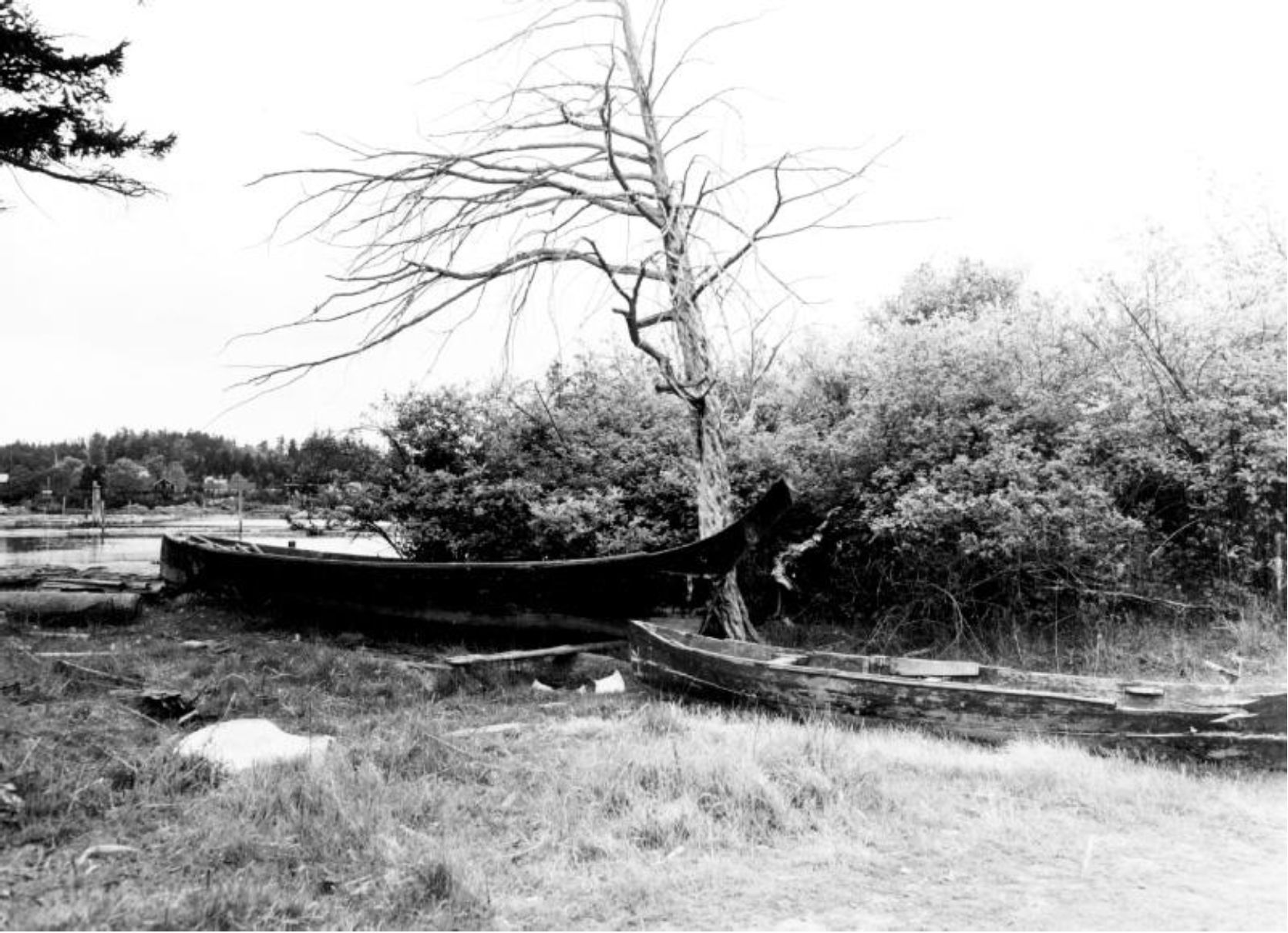
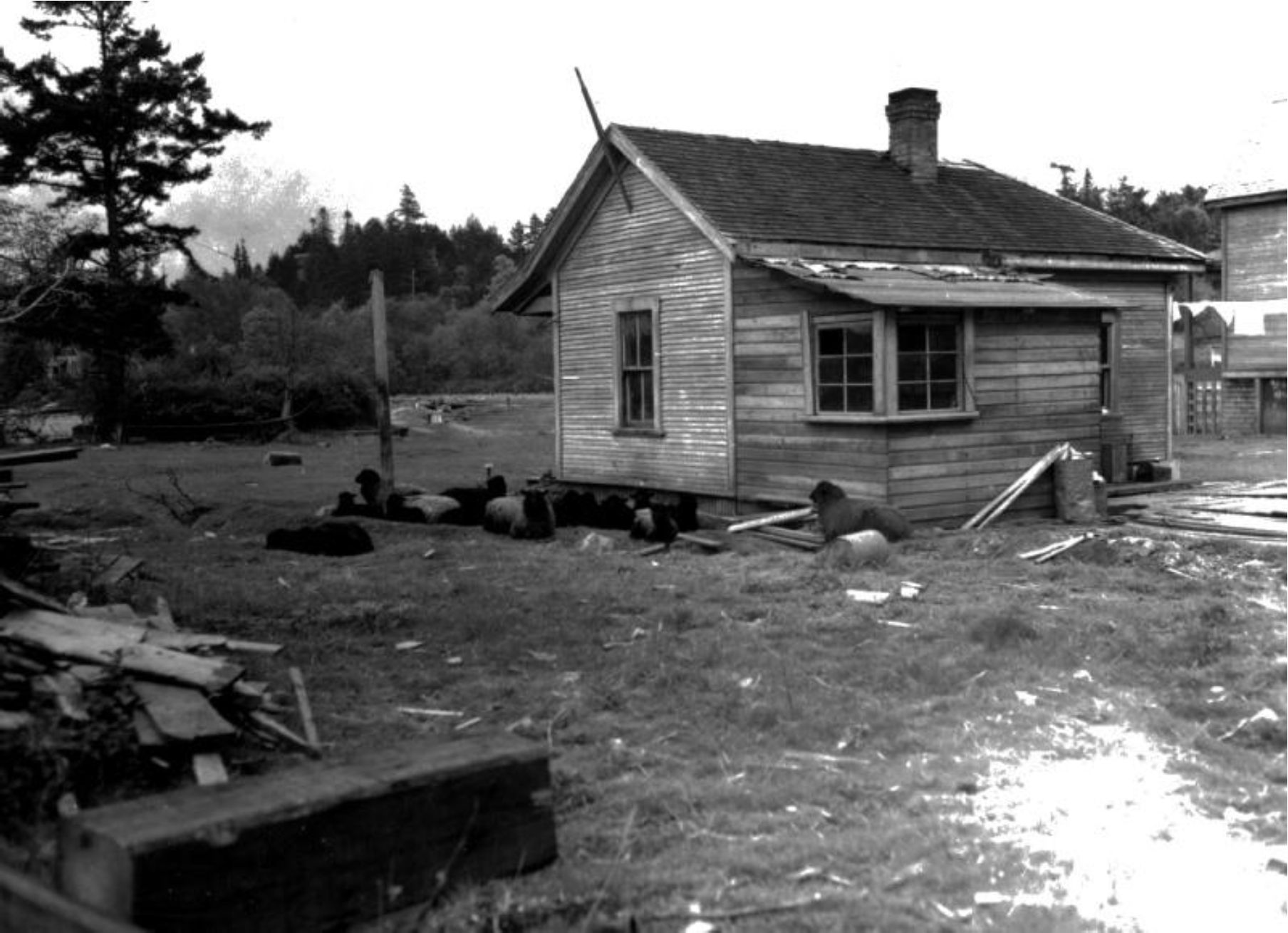
The sisters also had a brother Simon John and a half-brother Parry. Simon was married to Caroline Cecelia Roberts. Their children died young. Simon died on August 21, 1928 at age 36. Caroline re-married to Jasper Charles of Becher Bay who had a daughter Dorothy Jean from his first marriage. She died November 14, 1929 at age 11. Caroline and Jasper had seven more children: Caroline Rose Robinson; Phylis Muriel Planes; Ruth Leona Clark; Josephine Ann Morey; Delia Cecelia Clare; Joseph William and Gordon Lawrence.
The one time owner of the freight canoe, Louis George (indigenous name spelt Quin- tain-i-sihun and Qunteenian), was born on Discovery Island in July 1881. He had siblings Danny, Magdlen, Joshephine and Eddie. Louie married Agnes George who was born March 1, 1878, on the Old Songhees Reserve and died June 1, 1979 in Sooke (Figure 12). Agnes’s George family was unrelated to that of her husband Louis George. Her father was Henry George, another person who died in 1895 in the sinking of The Walter Earle, and her mother was Mary Tate (Born in Sooke, c. 1850, and died March 1956).
The original purchaser of the freight canoe, Jimmy Smith was an uncle of Agnes George according to Cecila Joe and Agnes Dick. This is verified by the published obituary of Jimmie Smith of Clo-oose (Born c. 1883. Died at age 48 on April 22, 1931).
It is noted that in addition to his wife, Jimmie was survived by five nieces, listed as Mrs Louie George, Mrs Elizabeth Edgar and Mrs Effie Edgar of Clo-oose and Miss Madaline Taite of Saanich. His Nephew Henry Tait is noted as being from Saanich. Jimmie’s father is noted on his death certificate as Joe Smith and his mother as unknown. The information was provided to the coroner by his neice, “Mrs Louie George” (Registration number 1931-09-995154). Effie Edgar was a sister of Agnes George.
This information suggests that Smith was the brother of one of Agnes’s parents Henry George or Mary Tate. Henry’s parents were from the Katzie band on the Lower Fraser River. We know that he was a nephew of the well known Katsie, Simon Pierrie, whose mother was Saanich with parents from Pat Bay and Brentwood Bay (see Suttles 1955:29).
The Tate family were from Clo-oose, where the freight canoe was used in earlier times. Agnes’s mother Mary Tate was the daughter of George MacQuinna Tate and Mary Patterson of Clo-oose. They had a son Henry Tate (Born c.1897, Died Feb. 7, 1958) and a daughter Madaline Tate who were also described as a nephew and niece of Smith but were of a previous generation to Agnes. Henry Tate married Jane Ashelina Bob. She was a Songhees born in 1918, and her father was a Saanich from Cole Bay. She was living in Clo-oose on Feb. 11, 1958. Their ten children have descendants around Vancouver Island. For more information on the Ditidaht territory and surrounding areas see Arima (1991), Bouchard and Kennedy (1991&1994) and Kennedy (2010 & 2018).
The Location of the “derelict” Canoe on the New
Songhees Reserve
There is a photograph of the freight canoe, figure 13, siting on wooden boards near the shore on the east side of the Maplebank portion of the Songhees Reserve. The location can be seen in the left background in the photograph in figure 16 behind a small house owned by the Dick family. A portion of the house Agnes and Cecilia were living in when the canoe was purchased can be seen on the right side of the small house. Figure 15 shows the location where the canoe was stored above the beach and later where it was located in the front yard of the house lived in by Agnes Dick and Cecilia Joe. Of the two long houses next to the road the one of the right was originally % owned by Jack Dick and % by Alex Peter. Later it was % owned by Harry ( “Huttie or Hattie”) Dick and % by Alex Peter and Dave Fallardeau. Figure 16 shows Hutty Dick and his two older sons on the beach at Maplebank. Edward Dick said that his father Hutty Dick was the last canoe maker on the Songhees reserve and made canoes for some Saanich people.

Clo-oose and Freight Canoes
We cannot be certain where the museum freight canoe was made or who first used it, but it would have been used at Clo-oose. This is where the first owner Jimmie Smith was from and we know that he was an uncle of the wife of the next owner of the canoe Louis George. As there were no landing facilities for larger boats at Clo-oose passengers and freight were ferried from the larger steamer boats off shore in large dugout canoes (Bruce 1971:65).
Agnes George’s sister was married into the Edgar family. A Clo-oose village Ditidaht, Joshua Edgar (Born 1894), was the village postmaster and mail carrier during the 1950s and early 1960s. He was one who regularly paddled out to the steamers off shore to get the mail.
“Joshua’s mode of travel was a good-sized dugout canoe which he had fashioned out of a large cedar log. Clo-oose was one of the very last centres where the ancient traditional carving of canoes, with rudimentary tools, was a fine art. Many exquisite examples of this native workmanship were completed by Joshua Edgar and even today at the age of 76 he sets to work with well worn adze whenever a suitable cedar tree is washed ashore” (Hammer 1970).
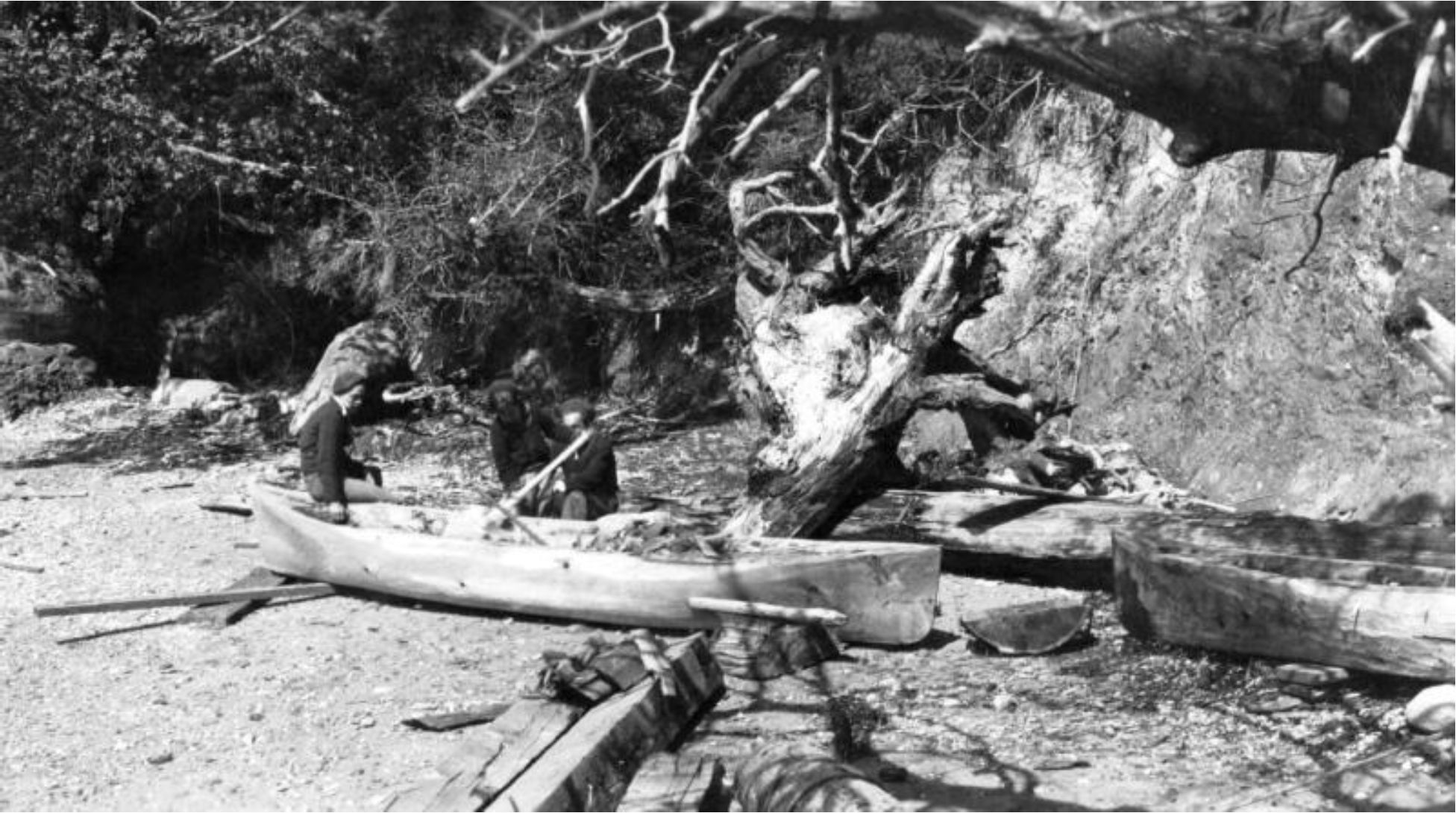
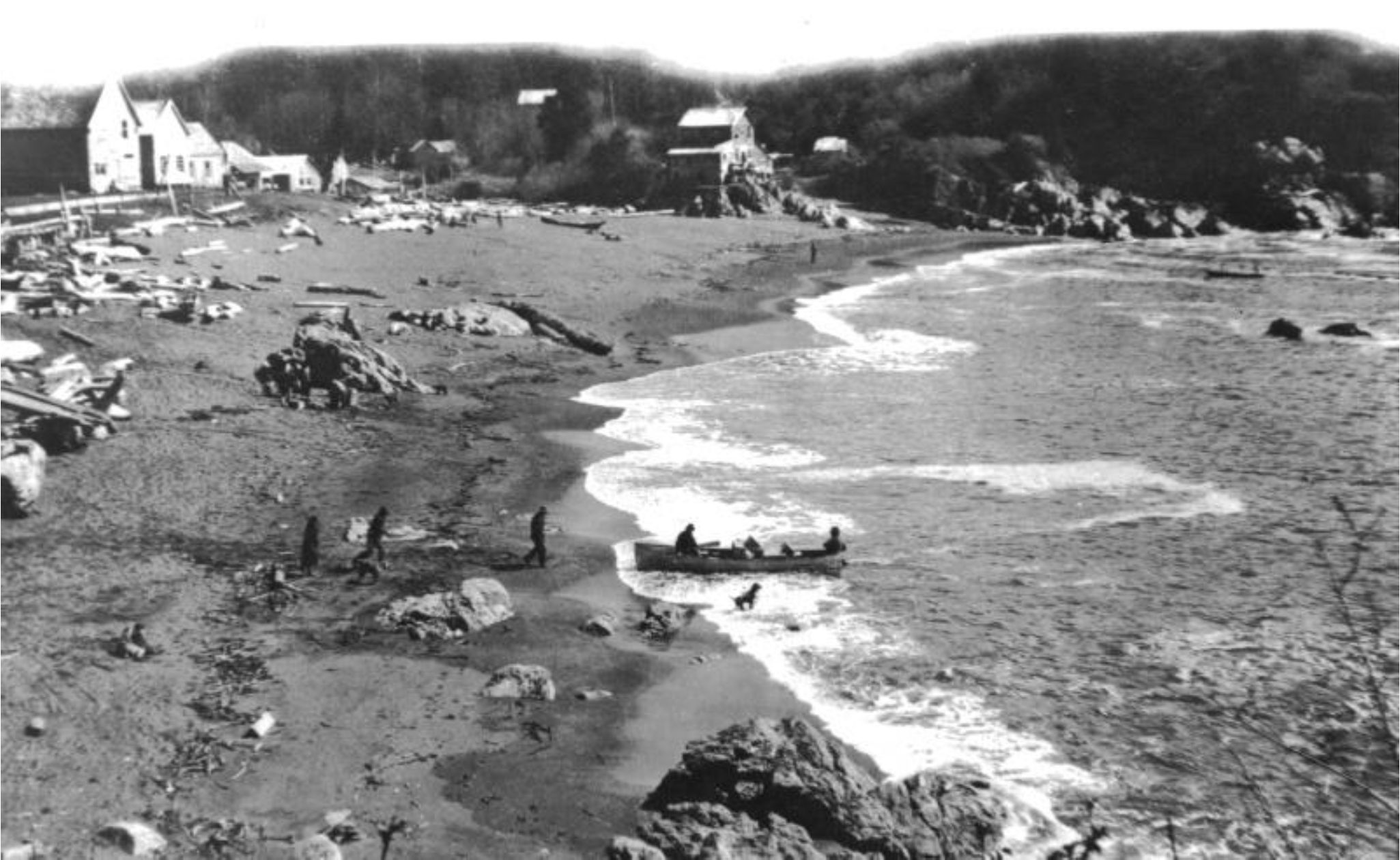
Discussion
Anthropologist Wayne Suttles had pointed out long ago that we need to be aware not to see Coast Salish as a single homogenous entity and recognize that they are speakers of 14 different languages that have their own regional histories (Suttles 1987; 1989).
Anthropologist Dorothy Kennedy in her doctoral thesis (Kennedy 2000) did an analysis of the indigenous and contemporary social organization of the Coast Salish people of southwestern British Columbia and northwestern Washington State, with a focus on the Squamish Nation. Her thesis provides the best example showing the historic complexities of Indigenous peoples on a multi-regional scale.
The story of this canoe is a tiny reflection of that bigger perspective. We see in the movement of this freight canoe, and its linkage to many people, a regional example of historic changes across even larger cultural boundaries – between speakers of two larger unrelated languages families.
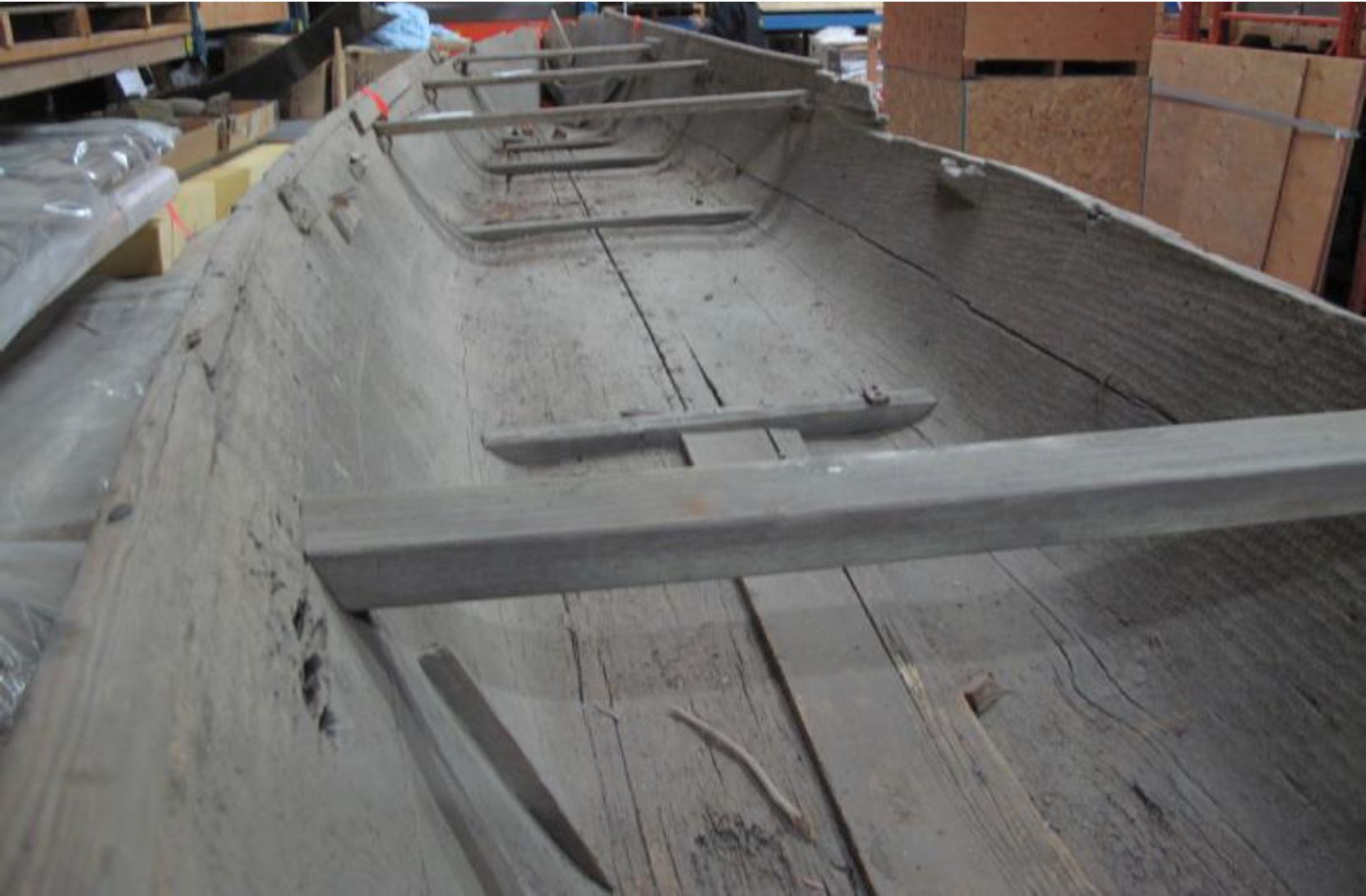
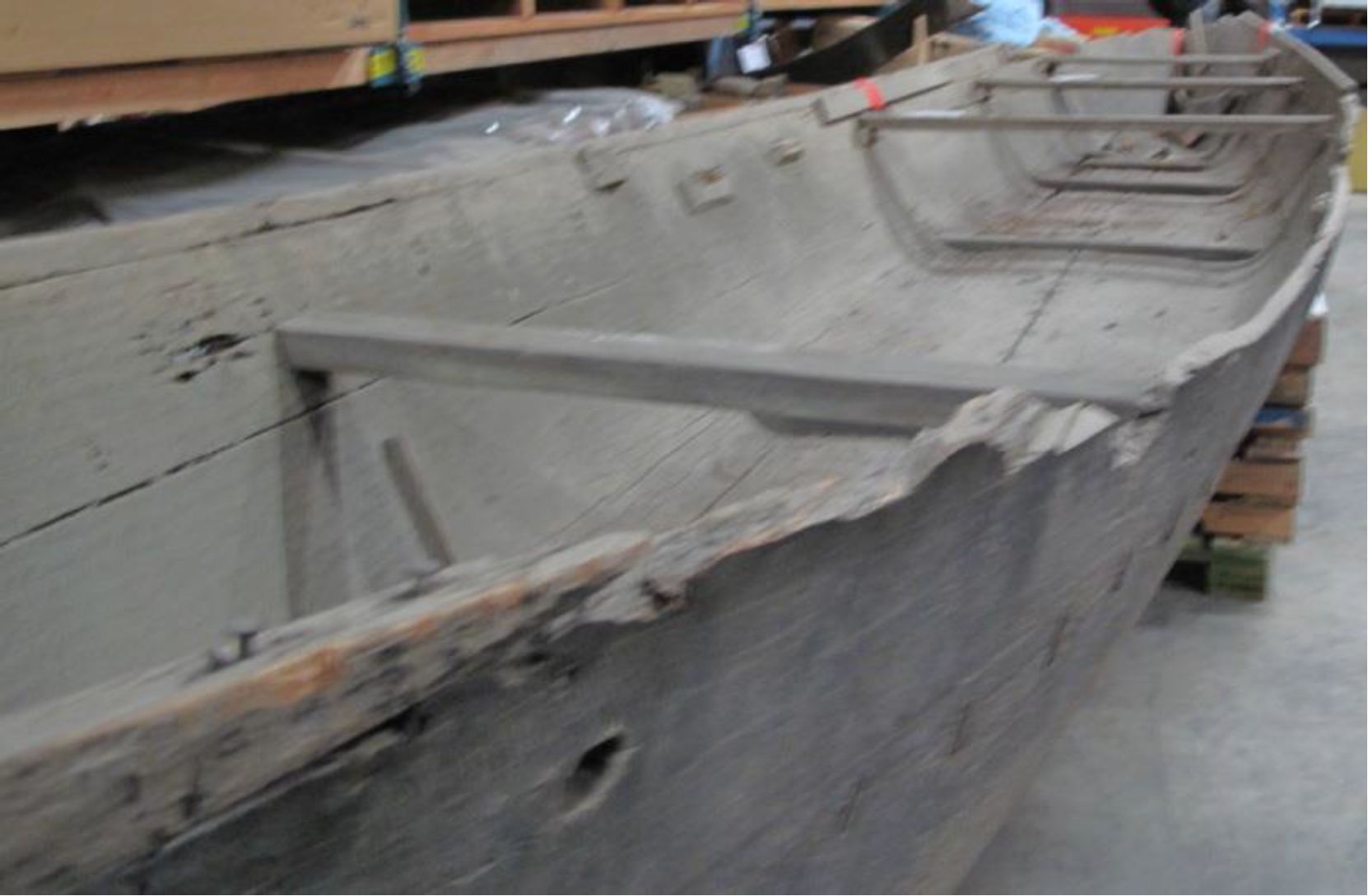
Notes
*1 In addition to the published references list here, the information on the genealogy presented is from Royal BC Museum archives’ birth, death and marriage records, newspaper accounts, court records; information shared with me in 1996 by Cary George of Sooke – that she obtained from interviews with Edward Matthew George of Sooke in c. 1868-70 and others at various times. Cary George acknowledged that she was assisted by Joesphine George with the pronunciation and writing of the indigenous names. I obtained information from Edward (“Pally”) and Thelma Dick, Delia Cecelia Clare and John Albany in the 1970-80s and from personal communication with Wayne Suttles in 1996-2001. Suttles obtained information from a 1949 interview with Mary George, the mother-in-law of Agnes George and in 1952 with Cecilia Joe. Suttles published some of this information in his 1974 publication.
References
Arima, Eugene Y, Denis St. Claire, Louis Clamhouse, Joshua Edgar, Charles Jones, and John Thomas. 1991. Between Ports Alberni qand Renfrew: Notes on West Coast People. Ottawa: Canadian Museum of Civilization.
Bouchard, Randy and Dorothy Kennedy. 1991. Preliminary Notes on Ditidaht Land Use. Report prepared for Millennia Research, the Ditidaht Indian Band and the British Columbia Heritage Trust.
Bouchard, Randy and Dorothy Kennedy. 1994. Ditidaht Indian Place Names and Site Use. Preliminary draft report of behalf of the Ditidaht Indian Band (28 February 1994).
Duff, Wilson (ed). 1955. Katzie Ethnographic Notes. Wayne Suttles. The Faith of
a Coast Salish Indian. Diamond Jenness. Anthropology in British Columbia Memoirs Nos. 2 &3. British Columbia Provincial Museum.
Hammer, Les. Joshua Edgar’s One Man Village. Clo-oose, B.C. The Daily Colonist April 26, 1970.
Gunther, Erna. Klallam Ethnography. University of Washington Publications in Anthropology. 1(5)171-314, January 1927. University of Washington Press, Seattle, Washington.
Kennedy, Dorothy Irene. 2000. Threads to the Past: The Construction and Transformation of Kinship in the Coast Salish Social Network. A Thesis Submitted to the University of Oxford for the Degree of Doctor of Philosophy. Trinity Term 2000.
Kennedy, Dorothy. Topegeny Among the Ditidaht.
2010. https://www.academia.edu/14264739/Topogeny Among the Ditidaht
Kennedy, Dorothy. Ditidaht. 2018. The Canadian Encyclopedia. On-line June 6, 2011. Edited November 9, 2018.
Royal BC Museum Archives. 1865. Police Court Records Manuscript GR419, Box 4.
Royal BC Museum Archives. 1875. GR1727. Court Records. Bench Book 45314.
Royal BC Museum Archives. Death Registry. # 1931-09-995154: Jimmie Smith Died 1931-04-22. Informant Mrs Louie George of Saanich.
Scott, R. Bruce. 1971. Stormy Landing. The Daily Colonist May 9.
Suttles, Wayne. 1955. Anthropology in British Columbia. Memoir No. British Columbia Provincial Museum. Department of Education. Victoria, B.C.
Suttles, Wayne. 1974. The Economic Life of the Coast Salish of Haro and Rosario Straits. In: Coast Salish and Western Washington Indians 1. Garland Publishing Inc., New York.
Suttles, Wayne. 1987. Cultural Diversity within Coast Salish Continuum. Pp. 243249. In: Ethnicity and Culture. Reginald Auger, Margaret F. Glas, Scott MacEachearn, and Peter H. McCaertney (eds), Calgary, University of Calgary.
Suttles, Wayne. 1989. Essentialism on the Northwest Coast. A Paper given at the Native American Art Studies Association Conference, August 1989,Vancouver, B.C.
The Daily Colonist. 1931. Obituary of Jimmie Smith. April 23:5.
The Daily Colonist. 1959. On Sooke Reserve Clan Will Gather. By John Shaw editor The Islander. Sundey Dec. 6 p. 45.
Williams, Margaret. 1966. Cecelia Joe Remembers. The Daily Colonist. September 25, 1966.
